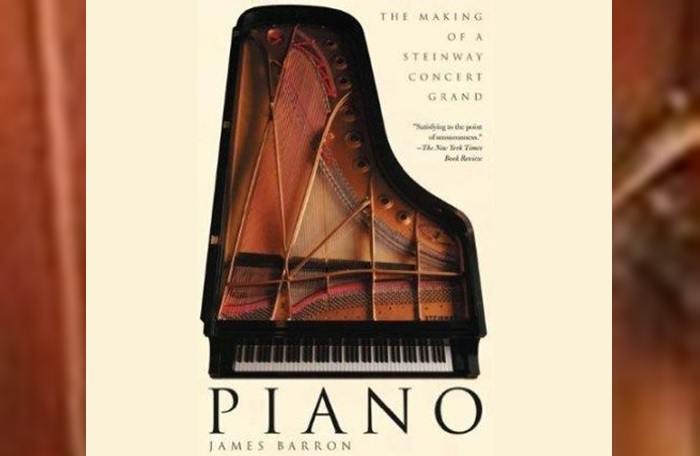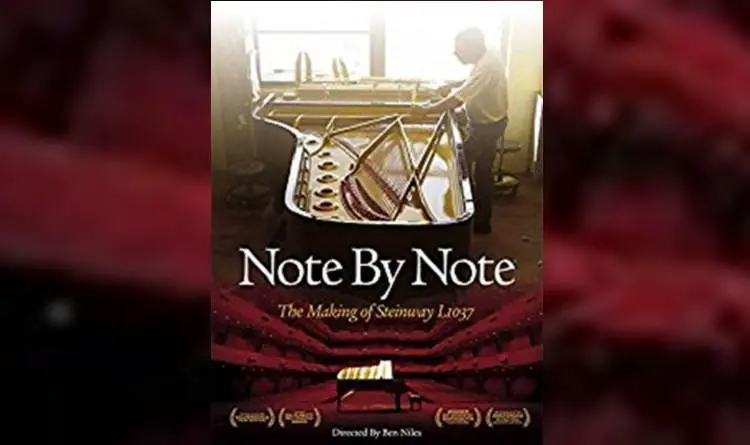
Best books and videos on the Making of a Steinway Piano.
Piano: The Making of a Steinway Concert Grand (Book)
The Making of a Steinway Concert Grand Piano is written by a New York Times reporter James Barron. It takes a fascinating and detailed look into Steinway history, its building process (and even performance). Throughout the book, you will find yourself saying – that is so cool!

By the time you reach the end of the book, you’re going to appreciate their craftsmanship, how they hand-make each piano, and accept that each piano really is a piece of art. While this book may not be for everybody, if you have ever played the piano, have ever seen a grand piano, or listened to piano music, are a music/piano hobbyist, then this might be for you. And yes, you really don’t have to be a musical genius to appreciate this book. Read about the people involved and the legendary craftsmanship that goes into the making of a single Steinway piano. Steinway pianos are still crafted largely by hand, imbuing each one with the promise and burden of its brand. [easyazon_link identifier=”0805078789″ locale=”US” tag=”keytarhq04-20″]Buy Piano: The Making of a Steinway Concert Grand on Amazon[/easyazon_link].
An acoustic grand piano is an engineering marvel that incorporates the thunder of a full-throated bass, the bright, delicate trill of the upper treble. And Steinway is definitely one of the few piano brands to have mastered this art.
In this captivating narrative, James Barron of The New York Times tells the story of one Steinway piano, from raw lumber to finished instrument. Barron follows that brand-new piano–known by its number, K0862–on its eleven-month journey through the Steinway factory, where time-honored manufacturing methods vie with modern-day industrial efficiency.
He looks over the shoulders of men and women (some second and third-generation employees) who transform wood and steel into a concert grand. You become attached to the characters responsible for bringing forth this work of art.
The book goes all the way to the forests from where the right wood is chosen. The history of the Steinway company is woven into this description.
- Understand the complexities of building a great instrument (Steinway crafts all of its pianos largely by hand)
- Understand the art and science of developing a piano’s timbre and character before its first performance
- In today’s world where everything is mass produced, there are people who can claim to be professional craftsmen
- Learn about the evolution of the piano and the piano music business
The book doesn’t go into the technicalities of how the piano sound is produced or why it sounds different from other keyboard instruments, it’s not very clear why the development of the cast iron plate was so important. The book doesn’t go into such details; perhaps it would have benefited certain readers. You can read the book to enjoy a story, learn about a process, a culture, and a history.
This book gives a fascinating account of building a Steinway grand piano; from start to finish, the ‘Piano’ will undoubtedly charm and enlighten music lovers. Highly recommended for piano lovers.
Buying Links
- [easyazon_link identifier=”0805078789″ locale=”US” tag=”keytarhq04-20″]Buy on Amazon[/easyazon_link] | Buy on iTunes
Watch: The Making of a Steinway – A Steinway & Sons Factory Tour Narrated by John Steinway
‘Note by Note’: Documentary video on the making of Steinway L1037 concert grand piano
Note By Note is a magnificent documentary video on how Steinway pianos are made. The video is a wonderful story about the creation of art using physical tools and will appeal to people of all ages.

This documentary video chronicles the making of a Steinway grand piano (the Steinway L1037).
However, its not a thorough, technical guide Instead, the video provides an overview of the several processes involved in the extremely time-consuming manufacture, adjustment, tuning and testing of the instrument. Compared to other piano manufacturers, Steinway makes fewer pianos – around 2,000 pianos per year.
Despite availability of modern techniques, Steinway still uses traditional techniques and old-world philosophy to produce instruments that accomplished musicians love to play. In this age of mass production, Steinway piano makers are a dying breed: skilled cabinet-makers, gifted tuners, thorough hand-crafters.
Did you know that Steinway still tunes their pianos aurally (as opposed to electronically).
The most thoroughly handcrafted instruments in the world, Steinway pianos are as unique and full of personality as the world-class musicians who play them.
NOTE BY NOTE follows the creation of a Steinway concert grand, #L1037, from forest floor to concert hall. Each piano’s journey is complex, spanning 12 months, 12,000 parts, 450 craftsmen, and countless hours of fine-tuned labor.
The video has been filmed at key Steinway locations; the factory, Steinway’s reserved Bank, and the rooms of private auditions.
Buying Links
[easyazon_link identifier=”B002ZRX9GI” locale=”US” tag=”keytarhq04-20″ cart=”n”]Buy ‘Note by Note’ on Amazon[/easyazon_link].
Useful Read:
- Piano: The Making of a Steinway Concert Grand (Book)
- Steinway range of pianos
- What It Takes to Make a Steinway Grand Piano
Checkout more books here.
KeytarHQ editorial team includes musicians who write and review products for pianists, keyboardists, guitarists & other musicians. KeytarHQ is the best online resource for information on keyboards, pianos, synths, keytars, guitars and music gear for musicians of all abilities, ages and interests.



Musicians have a special relationship with their instruments, even I have. I name them based on their personalities and abilities. I take time to get to know them, figuring out the best way to play them to achieve what I want. I avoid some because they don’t feel right, whereas others become favorites that I miss playing when they are no longer available. I have heard some musicians refer to them as instruments, but I have experienced that rare and intangible moment of ecstasy when the instrument becomes not just an extension of me, but a part of me, providing pure bliss.
My relationship with my piano—which is not a Steinway, but a roughly 30-year-old sturdy and well-made American Baldwin upright—is an intimate and personal one. I’ve turned to it at times of great sadness, all-consuming anger, fulfilling peace and joy, and it is always there to help me express whatever it is I am feeling. (My mother said when I was in high school she could always tell the kind of day I had by how I practiced piano when I got home.) I’ve explored what goes on under the lid by watching the hammers strike the strings as I play a scale. I have placed my bare foot up against the soundboard to feel the vibrations of the strings and better connect with what is beginning at my fingers and traveling through wood and metal to make music. It is capable of expressing every emotion, from great passion to tender sensitivity, is sometimes large and masculine and other times gently feminine and years of playing it has taught me just how to stroke the keys get the sound that I want. Almost every piece of music I’ve written has begun on my piano and it is the only thing in my life I can truly imagine not being able to live without. Piano requires your complete attention to play and years of your life to master. A piano isn’t just a means to make music, it is door to another plane of existence.
It is with this attitude that I approached Piano: The Making of a Steinway Concert Grand by James Barron.
I’ve always been aware of the mechanics that go into the 88 keys. I notice if a hammer is off-center, or if the humidity has made the wood loosen ever so slightly creating annoying rattles. I am on the phone with my tuner the second a key starts to stick or when the tell-tale wavering in a note tells me that its regular tuning is required. But I never much thought about what goes into making all of that work correctly in the first place. Barron’s book has completely changed all that.
It takes a year to make a Steinway grand. It takes even longer to season it and nurture it into the piano that the Steinway name is known for. Thousands of parts and pounds of pressure have to be combined ever so perfectly to ensure that the piano will play correctly, and yet there is is still something else required, a ‘je ne sais quoi’ (hard to put into words) that gives it the true character of a great piano. What is it that creates this? Not even the makers know. They create the same wood pieces, from the same kind of trees, using the same processes developed over 100 years ago and yet, every piano is different. And every pianists reaction to it is different. This is what I found most fascinating about the the story of K0862. It is unique. Just as every pianist will play its keys in a different way, it will sound them different from all other pianos that bear the same name and case.
This book isn’t just about the making of one piano, but of the history and evolution of the instrument and an American company of German immigrants whose legacy is not only permanent improvements that are a part of every modern piano, but a name of distinction and quality that is becoming all too rare. Barron relays the precision required to fashion the instrument’s many pieces, but also the human side of piano-making when telling the story of the many workers who are a part of the construction of the instrument. I enjoyed every part of the book, not just as a piano lover, but also as a story lover.
I found the book a bit dry, especially in the first half, where the focus is more on how the piano is made. Once the piano is ready and ready to be played, the author makes it interesting by generating suspense about what will happen to it, which I liked reading.